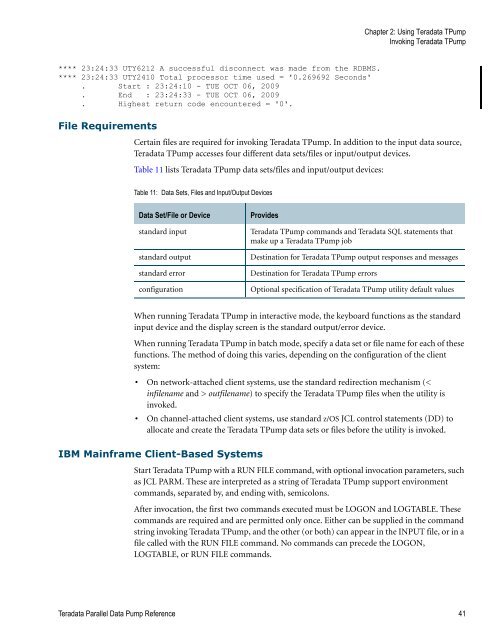Teradata Parallel Data Pump
Teradata Parallel Data Pump Reference - Teradata Developer ...
Teradata Parallel Data Pump Reference - Teradata Developer ...
- No tags were found...
Create successful ePaper yourself
Turn your PDF publications into a flip-book with our unique Google optimized e-Paper software.
Chapter 2: Using <strong>Teradata</strong> T<strong>Pump</strong><br />
Invoking <strong>Teradata</strong> T<strong>Pump</strong><br />
**** 23:24:33 UTY6212 A successful disconnect was made from the RDBMS.<br />
**** 23:24:33 UTY2410 Total processor time used = '0.269692 Seconds'<br />
. Start : 23:24:10 - TUE OCT 06, 2009<br />
. End : 23:24:33 - TUE OCT 06, 2009<br />
. Highest return code encountered = '0'.<br />
File Requirements<br />
Certain files are required for invoking <strong>Teradata</strong> T<strong>Pump</strong>. In addition to the input data source,<br />
<strong>Teradata</strong> T<strong>Pump</strong> accesses four different data sets/files or input/output devices.<br />
Table 11 lists <strong>Teradata</strong> T<strong>Pump</strong> data sets/files and input/output devices:<br />
Table 11: <strong>Data</strong> Sets, Files and Input/Output Devices<br />
<strong>Data</strong> Set/File or Device<br />
standard input<br />
standard output<br />
standard error<br />
configuration<br />
Provides<br />
<strong>Teradata</strong> T<strong>Pump</strong> commands and <strong>Teradata</strong> SQL statements that<br />
make up a <strong>Teradata</strong> T<strong>Pump</strong> job<br />
Destination for <strong>Teradata</strong> T<strong>Pump</strong> output responses and messages<br />
Destination for <strong>Teradata</strong> T<strong>Pump</strong> errors<br />
Optional specification of <strong>Teradata</strong> T<strong>Pump</strong> utility default values<br />
When running <strong>Teradata</strong> T<strong>Pump</strong> in interactive mode, the keyboard functions as the standard<br />
input device and the display screen is the standard output/error device.<br />
When running <strong>Teradata</strong> T<strong>Pump</strong> in batch mode, specify a data set or file name for each of these<br />
functions. The method of doing this varies, depending on the configuration of the client<br />
system:<br />
• On network-attached client systems, use the standard redirection mechanism (<<br />
infilename and > outfilename) to specify the <strong>Teradata</strong> T<strong>Pump</strong> files when the utility is<br />
invoked.<br />
• On channel-attached client systems, use standard z/OS JCL control statements (DD) to<br />
allocate and create the <strong>Teradata</strong> T<strong>Pump</strong> data sets or files before the utility is invoked.<br />
IBM Mainframe Client-Based Systems<br />
Start <strong>Teradata</strong> T<strong>Pump</strong> with a RUN FILE command, with optional invocation parameters, such<br />
as JCL PARM. These are interpreted as a string of <strong>Teradata</strong> T<strong>Pump</strong> support environment<br />
commands, separated by, and ending with, semicolons.<br />
After invocation, the first two commands executed must be LOGON and LOGTABLE. These<br />
commands are required and are permitted only once. Either can be supplied in the command<br />
string invoking <strong>Teradata</strong> T<strong>Pump</strong>, and the other (or both) can appear in the INPUT file, or in a<br />
file called with the RUN FILE command. No commands can precede the LOGON,<br />
LOGTABLE, or RUN FILE commands.<br />
<strong>Teradata</strong> <strong>Parallel</strong> <strong>Data</strong> <strong>Pump</strong> Reference 41









